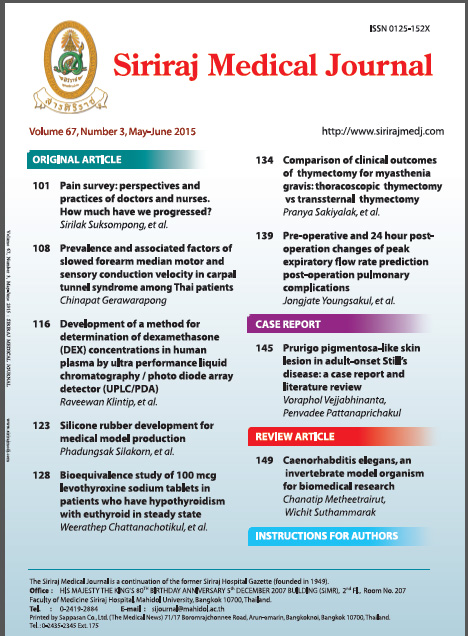Prevalence and Associated Factors of Slowed Forearm Median Motor and Sensory Conduction Velocity in Carpal Tunnel Syndrome among Thai Patients
Abstract
Objective: This study aimed to investigate the prevalence and relationship between the associated factors and slowed forearm median motor and sensory conduction velocity (FMMCV and FMSCV) in the carpal tunnel syndrome (CTS).
Methods: The study was conducted from June 2012 to March 2014. There was a total of 69 CTS hands (n = 38) and 13 non-CTS hands (n = 10) from 82 patients’ hands (n = 48). The slowed FMMCV and FMSCV were determined by less than 50 m/s. Demographic and clinical characteristics, FMMCV, FMSCV, and electrodiagnostic (EDX) findings related to the slowed FMMCV and FMSCV were compared and analyzed.
Results: The prevalence of slowed FMMCV in CTS was 31.6% and slowed FMSCV was 23.7%, respectively. Correlation between EDX parameters and slowed FMMCV were significantly correlated to the absence of compound muscle action potential (CMAP) amplitude (p-value = 0.006). For the slowed FMSCV, the small sensory nerve action potential (SNAP) amplitude also demonstrated significant correlation (p-value < 0.001). Among FMMCV, the occurrence of retrograde axonal atrophy (RAA) with retrograde conduction slowing (RCS) was significantly associated with the slowed FMMCV (OR 2.100; 95% CI 0.434-3.766; p-value = 0.013). For FMSCV, an increase of small SNAP amplitudes was significantly associated with slowed FMSCV (OR 4.210; 95% CI 2.031-6.390; p-value < 0.001).
Conclusion: These results support the hypothesis that slowed FMMCV is significantly ascribed to RAA with RCS and warrants further investigation into the role of the mechanism of slowed FMSCV in CTS. Furthermore, this study supports the findings of other studies that the damage to nerve function does not occur only in segments distal to the site of injury or compression.
Keywords: Forearm median motor conduction velocity, forearm median sensory conduction velocity, carpal tunnel syndrome, retrograde axonal atrophy, retrograde conduction slowing
Downloads
Published
How to Cite
Issue
Section
License
Authors who publish with this journal agree to the following conditions:
Copyright Transfer
In submitting a manuscript, the authors acknowledge that the work will become the copyrighted property of Siriraj Medical Journal upon publication.
License
Articles are licensed under a Creative Commons Attribution-NonCommercial-NoDerivatives 4.0 International License (CC BY-NC-ND 4.0). This license allows for the sharing of the work for non-commercial purposes with proper attribution to the authors and the journal. However, it does not permit modifications or the creation of derivative works.
Sharing and Access
Authors are encouraged to share their article on their personal or institutional websites and through other non-commercial platforms. Doing so can increase readership and citations.










